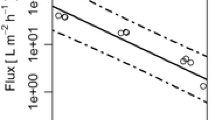Abstract
Membrane separation techniques are extensively used in dairy industry both for milk and cheese whey processing. However, cheese whey might still be considered as a problematic waste despite its high content of many valuable substances, such as proteins, lactose or minerals, which can be further used, e.g. in human nutrition, pharmacy or biotechnologies. Another problem, which food technologists have to face, is variable quality, composition and properties of food materials bringing high demands on manufacturing industry. In this paper, filtration kinetics and separation efficiency during purification and fractionation of cheese whey (sweet and salty) from Czech dairies by pilot-plant filtration (Bollene, France) was studied using tubular membranes (Membralox, USA). Various mineral membranes’ cut-offs were tested and all experiments ran in the retentate recycling mode. The obtained mass concentration factors were between 1.9 and 16.5. Steady state fluxes were calculated from the experimental data using a mathematical model. Fine ultrafiltration on a 5 kDa membrane gave steady state fluxes of 14–19 L m−2 h−1. The coarse pre-filtration on 100 nm, 200 nm or 500 nm membranes showed various permeate fluxes between 22 L m−2 h−1 and 153 L m−2 h−1. Despite the high pore sizes of the used membranes, lactose was partially rejected by all membranes tested.
Similar content being viewed by others
References
Aimar, P., Taddei, C., Lafaille, J. P., & Sanchez, V. (1988). Mass transfer limitations during ultrafiltration of cheese whey with inorganic membranes. Journal of Membrane Science, 38, 203–221. DOI: 10.1016/s0376-7388(00)82420-5.
Almécija, M. C., Ibáñez, R., Guadix, A., & Guadix, E. M., (2007). Effect of pH on the fractionation of whey proteins with a ceramic ultrafiltration membrane. Journal of Membrane Science, 288, 28–35. DOI: 10.1016/j.memsci.2006.10. 021.
Atra, R., Vatai, G., Bekassy-Molnar, E., & Balint, A. (2005). Investigation of ultra- and nanofiltration for utilization of whey protein and lactose. Journal of Food Engineering, 67, 325–332. DOI: 10.1016/j.jfoodeng.2004.04.035.
Brans, G., Schröen, C. G. P. H., van der Sman, R. G. M., & Boom, R. M. (2004). Membrane fractionation of milk: state of the art and challenges. Journal of Membrane Science, 243, 263–272. DOI: 10.1016/j.memsci.2004.06.029.
Blaschek, K. M., Wendorff, W. L., & Rankin, S. A. (2007). Survey of salty and sweet whey composition from various cheese plants in Wisconsin. Journal of Dairy Science, 90, 2029–2034. DOI: 10.3168/jds.2006-770.
Corbatón-Báguena, M. J., Álvarez-Blanco, S., & Vincent-Vela, M. C. (2015). Fouling mechanisms of ultrafiltration membranes fouled with whey model solutions. Desalination, 360, 87–96. DOI: 10.1016/j.desal.2015.01.019.
Cheryan, M., & Kuo, K. P. (1984). Hollow fibers and spiral wound modules for ultrafiltration of whey: Energy consumption and performance. Journal of Dairy Science, 67, 1406–1413. DOI: 10.3168/jds.s0022-0302(84)81455-1.
Cheryan, M. (1998). Ultrafiltration and microfiltration handbook (2nd ed.). Urbana, IL, USA: Technomic Publishing Company.
Cheang, B. L., & Zydney, A. L. (2004). A two stage ultrafiltration process for fractionation of whey protein isolate. Journal of Membrane Science, 231, 159–167. DOI: 10.1016/j.memsci.2003.11.014.
Doyen, W., Andriansens, W., Molenberghs, B., & Leysen, R. (1996). A comparison between polysulfone, zirconia and organo-mineral membranes for use in ultrafiltration. Journal of Membrane Science, 113, 247–258. DOI: 10.1016/0376-7388(95)00124-7.
Hanemaaijer, J. H., Robbertsen, T., van den Boomgaard, T., & Gunnink, J. W. (1989). Fouling of ultrafiltration membrane: The role of protein adsorption and salt precipitation. Journal of Membrane Science, 40, 199–217. DOI: 10.1016/0376-7388(89)89005-2.
International Association for Cereal Science and Technology (1996). ICC standard methods: Determination of crude protein in cereals and cereal products for food and for feed. ICC 105/2. Vienna, Austria.
Konrad, G., Kleinschmidt, T., & Faber, W. (2012). Ultrafiltration flux of acid whey obtained by lactic acid fermentation. International Dairy Journal, 22, 73–77. DOI: 10.1016/j.idairyj.2011.08.005.
Maubois, J. L., & Ollivier, G. (1997). Extraction of milk proteins. In S. Damodaran, & A. Paraf (Eds.), Food proteins and their applications (pp. 225–256). New York, NY, USA: Marcel Dekker.
Merin, U., & Cheryan, M. (1980). Factors affecting the mechanism of flux decline during ultrafiltration of cottage cheese whey. Journal of Food Processing and Preservation, 4, 183–198. DOI: 10.1111/j.1745-4549.1980.tb00604.x.
Muller, A., Daufin, G., & Chaufer, B. (1999). Ultrafiltration modes of operation for the separation of a-lactalbumin from acid casein whey. Journal of Membrane Science, 153, 9–21. DOI: 10.1016/s0376-7388(98)00218-x.
Qin, J. J., Wong, F. S., Li, Y., & Liu, Y. T. (2003). A high flux ultrafiltration membrane spun from PSU/PVP (K90)/DMF/1,2-propanediol. Journal of Membrane Science, 211, 139–147. DOI: 10.1016/s0376-7388(02)00415-5.
Rao, H. G. R. (2002). Mechanisms of flux decline during ultrafiltration of dairy products and influence of pH on flux rates of whey and buttermilk. Desalination, 144, 319–324. DOI: 10.1016/s0011-9164(02)00336-3.
Räsänen, E., Nyström, M., Sahlstein, J., & Tossavainen, O. (2002). Comparison of commercial membranes in nanofiltration of sweet whey. Le Lait, 82, 343–356. DOI: 10.1051/lait: 2002015.
Suárez, E., Lobo, A., Álvarez, S., Riera, F. A., & Álvarez, R. (2006). Partial demineralization of whey and milk ultrafiltration permeate by nanofiltration at pilot plant scale. Desalination, 198, 274–281. DOI: 10.1016/j.desal.2005.12.028.
Yorgun, M. S., Balcioglu, I. A., & Saygin, O. (2008). Performance comparison of ultrafiltration, nanofiltration and reverse osmosis on whey treatment. Desalination, 229, 204–216. DOI: 10.1016/j.desal.2007.09.008.
Author information
Authors and Affiliations
Corresponding author
Rights and permissions
About this article
Cite this article
Hinkova, A., Bubnik, Z., Henke, S. et al. Cheese whey tangential filtration using tubular mineral membranes. Chem. Pap. 70, 325–332 (2016). https://doi.org/10.1515/chempap-2015-0191
Received:
Revised:
Accepted:
Published:
Issue Date:
DOI: https://doi.org/10.1515/chempap-2015-0191




